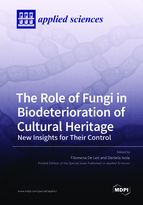The Role of Fungi in Biodeterioration of Cultural Heritage: New Insights for Their Control
A special issue of Applied Sciences (ISSN 2076-3417). This special issue belongs to the section "Applied Biosciences and Bioengineering".
Deadline for manuscript submissions: closed (30 November 2021) | Viewed by 29214
Special Issue Editors
Interests: biodeterioration of cultural heritage; applied microbiology; black fungi; molecular microbiology
Special Issues, Collections and Topics in MDPI journals
Interests: applied mycology; biodeterioration; biodegradation; biocides; cultural heritage low-impact cleaning methods; environmental microbiology; fungal diversity
Special Issues, Collections and Topics in MDPI journals
Special Issue Information
Dear Colleagues,
Cultural heritage in contemporary societies has a leading role in the promotion of important values such as knowledge, respect for diversity, intercultural dialogue, as well as economic and social growth. Therefore, the adoption of appropriate strategies for the preservation of cultural heritage is of the utmost importance.
Fungi occupy a wide variety of ecological niches in the biosphere (terrestrial and aquatic) and, due to their incredible metabolic versatility, significantly contribute to the deterioration of a huge number of substrates/materials, either organic or inorganic/natural or synthetic. Living on the surface, or just under it, fungi can cause serious problems, making the adoption of preventive and conservative strategies critical. Knowledge of the species involved in deterioration processes is undoubtedly useful, although not sufficient or decisive for discovering their ecological role and, above all, their involvement in deterioration processes.
Fungal control in cultural heritage artefacts is a major challenge for both biologists and restorers. The search for appropriate and efficient methods to stop or mitigate the progressive spread of fungi, while at the same time respecting the operator and the environment, is now a necessity.
With this Special Issue, we aim to publish outstanding papers with cutting-edge advances in the most advanced methods to study and control the fungi involved in the biodeterioration of cultural heritage.
Dr. Filomena De Leo
Dr. Daniela Isola
Guest Editors
Manuscript Submission Information
Manuscripts should be submitted online at www.mdpi.com by registering and logging in to this website. Once you are registered, click here to go to the submission form. Manuscripts can be submitted until the deadline. All submissions that pass pre-check are peer-reviewed. Accepted papers will be published continuously in the journal (as soon as accepted) and will be listed together on the special issue website. Research articles, review articles as well as short communications are invited. For planned papers, a title and short abstract (about 100 words) can be sent to the Editorial Office for announcement on this website.
Submitted manuscripts should not have been published previously, nor be under consideration for publication elsewhere (except conference proceedings papers). All manuscripts are thoroughly refereed through a single-blind peer-review process. A guide for authors and other relevant information for submission of manuscripts is available on the Instructions for Authors page. Applied Sciences is an international peer-reviewed open access semimonthly journal published by MDPI.
Please visit the Instructions for Authors page before submitting a manuscript. The Article Processing Charge (APC) for publication in this open access journal is 2400 CHF (Swiss Francs). Submitted papers should be well formatted and use good English. Authors may use MDPI's English editing service prior to publication or during author revisions.
Keywords
- yeast
- moulds
- microfungi
- black fungi
- microcolonial fungi
- lichens
- stone monuments
- wall paintings
- wooden artefacts
- waterlogged archaeological wood
- paper
- parchment
- textile
- leather
- mummies
- paintings
- glass
- biocides
- essential oils
- physical control methods
- eco-friendly biocide
- underwater archaeological site







